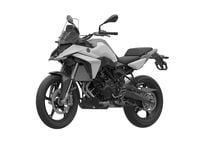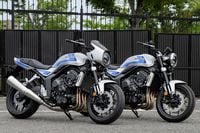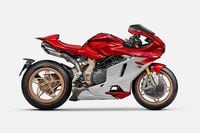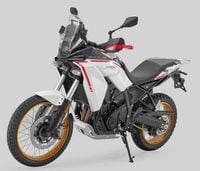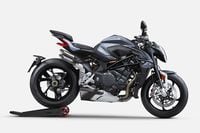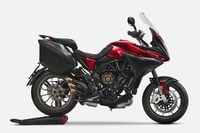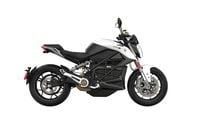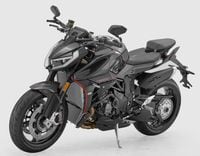If you’ve had an eye on MotoGP recently, you’ll have noticed that the subject of front tire pressure has become a hot topic—quite literally—as riders are forced to carefully manage the temperature of their rubber to avoid tripping over rules intended to prevent them from running too little pressure, which can cause tire failures. While the subject of Honda’s latest patent application depicts its new design on a humble 250cc streetbike it’s likely to be intended as a solution to that on-track problem.
Our own Kevin Cameron took a deep dive into the issue of MotoGP front tire heat last year, you can read his analysis here, but the short of it is that all MotoGP bikes have their tire pressures constantly monitored, and riders who are found to have spent too much of the race with their tires below a predetermined minimum are penalized. It’s intended to be a safety rule, preventing the use of dangerously low pressures that could damage the tire, but the unintended consequence has been that riders running at the head of a pack—with tires that are hitting cold air rather than the hot, turbulent gas coming off the back of another bike—are sometimes forced to drop back behind another bike for a portion of the race simply to maintain the mandated minimum front tire pressure, by raising its temperature and therefore pressure.
While Honda can’t control the heat coming off rivals’ bikes, its latest patent is intended to reduce the amount of brake temperature that gets transmitted to the tire. The document doesn’t specify that it’s intended for MotoGP, but in racing this solution could allow mechanics to start with a slightly higher initial tire pressure, knowing that hot brakes aren’t going to influence the pressure as much. Even beyond the problems of the current MotoGP rules about minimum pressures, the ability to decouple brake temperature from tire temperature could offer an advantage in terms of tire life and consistent performance.
The patent shows the design on a CBR250RR, an Asian-market parallel-twin streetbike. Even using that machine’s small, axial-mounted brake calipers rather than the massive, radial-mount designs used on modern racers isn’t an issue as those elements aren’t related to the substance of the patent itself so can be ignored in this context. What’s important are the huge brake discs that extend all the way to the center of the wheel—materials aren’t mentioned, but for a racer they would presumably be carbon rather than steel—and behind those, sandwiched between the discs and the wheel spokes, lie a pair of sculpted aerodynamic wheel covers intended to control the airflow.
Only the edges of the discs are gripped by the calipers, as on a conventional design, but the large center section acts as a heat sink, spreading the temperature over a wider area. The carefully designed wheel covers, largely hidden by the discs, serve two functions. The face that’s near the disc has bladelike aerodynamic elements to help dispel heat, while small bumps (marked “90” in the images) sit against the wheel rim itself, minimizing the contact between the cover and the wheel and maintaining a consistent air gap to insulate the wheel rim from heat that’s passed from the brake to the wheel cover. By stopping brake temperature from being passed to the wheel rim, in turn it’s prevented from leeching into the front tire.
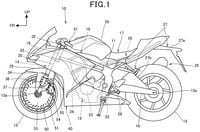


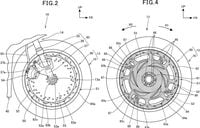
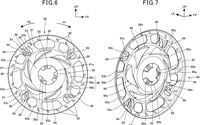
/cloudfront-us-east-1.images.arcpublishing.com/octane/RZ5QNVGN4ZDRHJIKTPHGDX3HKA.jpg)
/cloudfront-us-east-1.images.arcpublishing.com/octane/ZGBASNGFXVBGXAQGDM6EWLNFXA.jpg)
/cloudfront-us-east-1.images.arcpublishing.com/octane/54BEFUE3XBDCTCAYUYQNZGAJV4.jpg)
/cloudfront-us-east-1.images.arcpublishing.com/octane/5XF2ZKSOR5G7TO23KSYT4JADTU.jpg)
/cloudfront-us-east-1.images.arcpublishing.com/octane/VHUK3FH6WFHLTHN7CKCATU36LM.jpg)
/cloudfront-us-east-1.images.arcpublishing.com/octane/HC4P3CYOXFF3NGXCQTGORFRYNY.jpg)
/cloudfront-us-east-1.images.arcpublishing.com/octane/ZNANUJGGKVBIFH3VRZ32BYC454.jpg)
/cloudfront-us-east-1.images.arcpublishing.com/octane/JACAJ4MPKJBTDBOZRTHXZAKLTA.jpg)
/cloudfront-us-east-1.images.arcpublishing.com/octane/7L3YWQXRBRECXMWQ6NBVAHU2EY.jpg)
/cloudfront-us-east-1.images.arcpublishing.com/octane/BPD5CKH5IFGDLG67Y24UMOXXGA.jpg)
/cloudfront-us-east-1.images.arcpublishing.com/octane/CHQ32B6TVBEPVFNPERY3AB2H3M.jpg)
